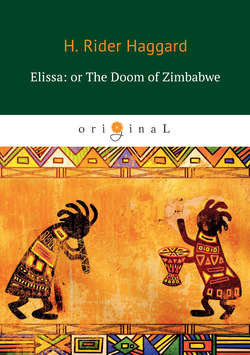Elissa: or The Doom of Zimbabwe

Реклама. ООО «ЛитРес», ИНН: 7719571260.
Оглавление
Генри Райдер Хаггард. Elissa: or The Doom of Zimbabwe
Author’S Note
Note
Chapter I. The Caravan
Chapter II. The Grove of Baaltis
Chapter III. Ithobal the King
Chapter IV. The Dream of Issachar
Chapter V. The Place of Sacrifice
Chapter VI. The Hall of Audience
Chapter VII. The Black Dwarf
Chapter VIII. Aziel Plights His Troth
Chapter IX. Greeting to the Baaltis
Chapter X. The Embassy
Chapter XI. Metem Sells Images
Chapter XII. The Tryst
Chapter XIII. The Sacrilege of Aziel
Chapter XIV. The Martyrdom of Issachar
Chapter XV. Elissa Takes Sanctuary
Chapter XVI. The Cage of Death
Chapter XVII "There is Hope"
Отрывок из книги
Of the three stories that comprise this volume, one, «The Wizard,» a tale of victorious faith, first appeared some years ago as a Christmas Annual. Another, «Elissa,» is an attempt, difficult enough owing to the scantiness of the material left to us by time, to recreate the life of the ancient Phœnician Zimbabwe, whose ruins still stand in Rhodesia, and, with the addition of the necessary love story, to suggest circumstances such as might have brought about or accompanied its fall at the hands of the surrounding savage tribes. The third, «Black Heart and White Heart,» is a story of the courtship, trials and final union of a pair of Zulu lovers in the time of King Cetywayo.
The researches of Mr. Wilmot prove to us indeed that in the Middle Ages Zimbabwe or Zimboe was the seat of a barbarous empire, whose ruler was named the Emperor of Monomotapa, also that for some years the Jesuits ministered in a Christian church built beneath the shadow of its ancient towers. But of the original purpose of those towers, and of the race that reared them, the inhabitants of mediæval Monomotapa, it is probable, knew less even than we know to-day. The labours and skilled observation of the late Mr. Theodore Bent, whose death is so great a loss to all interested in such matters, have shown almost beyond question that Zimbabwe was once an inland Phœnician city, or at the least a city whose inhabitants were of a race which practised Phœnician customs and worshipped the Phœnician deities. Beyond this all is conjecture. How it happened that a trading town, protected by vast fortifications and adorned with temples dedicated to the worship of the gods of the Sidonians – or rather trading towns, for Zimbabwe is only one of a group of ruins – were built by civilised men in the heart of Africa perhaps we shall never learn with certainty, though the discovery of the burying-places of their inhabitants might throw some light upon the problem.
.....
"How are you named, lady?" he said presently, adding "or rather I need not ask; you are Elissa, the daughter of Sakon, Governor of Zimboe, are you not?"
"I am so called, though how you know it I cannot guess."
.....